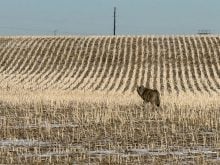The Canadian Wheat Board typically handles little feed wheat, but that’s not the case in 2010-11.
“We’re expecting a very strong feed wheat export program this year,” said Bruce Burnett, the CWB’s director of market analysis.
The board is competing with livestock producers and ethanol plants for poor quality wheat to meet the needs of an international market starved of feed grains.
Tight U.S. corn supplies and a dismal wheat harvest in the former Soviet Union created a feed shortage that doubled feed wheat prices.
Read Also

Agritechnica Day 3: Hybrid drive for a combine, data standards keep up to tech change and tractors of the year
Agritechnica 2025 Day 3: Hybrid drive for a combine, data standards keep up to tech change and tractors of the year.
The wheat board Pool Return Outlook price for feed wheat in Saskatchewan after deductions is $4.77 per bushel compared to $2.19 a year ago.
It’s a good thing demand is voracious because supply in Canada is plentiful. Burnett said 10 to 12 percent of the wheat crop typically lands in the feed grain category.
“It’s more than double this year. It’s up around a quarter,” he said.
There is also plenty of crop falling into the No. 4 grade, which is low quality milling wheat and typically accounts for less than one percent of the wheat crop.
Burnett estimates one-third of this year’s wheat is either feed or No. 4, which is about triple the normal volume in those two grades.
Dale Williamson, manager of supply and logistics with Terra Grain Fuels, which operates Canada’s largest wheat ethanol plant in Belle Plaine, Sask., is pleased there is plenty of feed wheat available but dismayed by the going rate for the product.
He estimates only 75 percent of the wheat Terra Grain contracted with area farmers was planted last spring, which means the company must buy more spot feed wheat than usual.
“We’re happy to have it available and definitely we have some buying that we need to do for the balance of the year to continue to keep the plant running,” said Williamson.
But the same product Terra contracted for $4.35 per bu. last spring now costs $4.90.
It wouldn’t be so bad if ethanol prices were rising in lockstep with grain prices, but that hasn’t been the case.
“They are climbing, just not to the same degree as the wheat prices are,” said Williamson.
“It’s making margins tighter. That’s definitely having to make us be more efficient on our processing to try to maximize the ethanol production.”
He has heard that some wheat ethanol plants are switching to corn, but that crop isn’t a bargain these days either.
Burnett said Australia’s glut of feed wheat caused by miserable harvest weather could be the “fly in the ointment” that lowers international prices.
It all depends on how much of Australia’s feed wheat is consumed by its domestic livestock sector and whether exporters can overcome some of the flood-related logistical problems of getting product to market. Answers to those questions probably won’t be known for a couple of months.
The price-damping effects of any competition Canada faces from Australia in feed wheat markets could easily be offset by further tightening in U.S. corn stocks, which would strengthen the overall feed grain complex.















